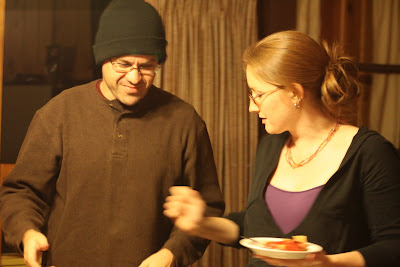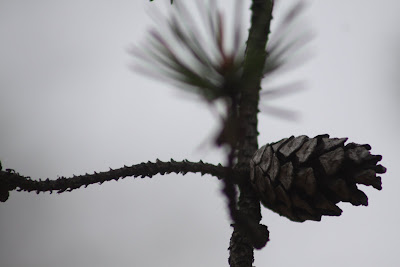
Transcribing my writing notebook.
Reading
Another Beauty:
The birth of a writer: a young man raised in the Catholic faith experiences a dazzling revelation. While praying, he suddenly realizes that he doesn't necessarily have to repeat what's printed in the missal. He can invent his own prayer. He can make up his own words. (pg 18)
A writer who keeps a personal diary uses it to record what he knows. In his poems or stories he sets down what he doesn't know. (pg 28)
Moments of revelation are like boundary stories, separated by several hundred yards of no-man's-land. The poet experiences an epiphany in setting down the key line of his latest poem. But days, weeks, even months of shadow stretch between those moments of majestic clarity. And here the poet plays the historian's role, sharing not just his ecstatic humanity with his readers but his dull, dreary, doubting humanity as well. (pg. 29)
Reading
Eternal Enemies, "from 'Rome, Open City'", pg 36:
poems are short tragedies, portable, like transistor radios...
poetry often vanishes, leaving on matchsticks
forgive my silence. forgive your silence.

Interview with Adam Zagajewski:
Colleen Coyne, editor-in-chief of
dislocate, and I spent forty-five minutes in conversation in a strange corner of Lind, where we discussed:
- what draws him back to the page again and again (the huge courage to write, the new tragedies and ecstasies to report, the ways in which youth plays into writing drive, the fact that there is no outcome but writing, it has become one's inner life)
- books to return to over and over (how poetry is not something you just read once, which is part of the contract with the book, he doesn't believe so much in the "great narrative," hates deconstruction, believes life can be lived as a narrative and as an instant--life in short moments, short moments of ecstasy, claims he is a library rat, a hunter of ecstatic moments)
- young writers to read (reluctant to name names--his encouragement was our finding, discovering on our own--but he did speak of coming not out of poetic ideology [he dislikes strong poetic fashions--interestingly, there's a
conversation in the comments of this post regarding fashion, canons, and popularity in poetry--feel free to join in!] and dislikes the poetic aesthetic but instead looks to writing from an individual moment)
- what work is coming up (a book called
Invisible Hand, just finished a new book and there is a sad feeling of a chapter that closed, after a book there are several months of poetic silence, has another book in computer which is a book of essays that combines elements of diary / essay / memoir, that time of silence contains contradictory feelings, feels it is bad when a writer is too prolific, which he later spoke about as watering down what a writer had to say, he spent five or six years on
Another Beauty, spent a great deal of time defining the final profile of the book)
- his writing process (poems more emotional, more irrational, poet who writes any essay has the same relationship with the truth)
- writing in Polish or English (intuitive--doesn't believe in analyzing translation and trusts his translator, who is mainly
Claire Cavanaugh, does write essays in English and not poetry, looks to an inner life that comes before the language, inner riches, fascinated by transformation of language--mentioned the way German on the street may sound ugly but on the page it is beautiful--Rilke)
- poetry communities (the New Wave is in the distant past, vibrant communities are given when we are young, emerge from the silence of childhood / imaginary childhood, form groups with our peers--a kind of love, growing older, solitude)
- individual versus political group (globalization, Poland is only twenty years of freedom after the collapse of communism, mass culture and entertainment, individual as almost heroic, love the neighbors' souls, responsibility to praise what's mine, privilege what is un-individual)
- what work he's most proud of (rarely thinks of past books, always concentrating on new books, small moments of poems having meaning)
- "by definition, you never find the truth in poetry"
Above I suppose I am transcribing some notes, and if you are interested in some kind of translation, you'll have to check out issue six of
dislocate, which will come out next spring!

AZ stopped by MDB's class, where the discussion continued:
- as a young poet, AZ was too shy to speak to Tadeusz Rozewicz when he lived in Gliwice
- admires poetry in translation--mentioned how some cite poetry as being a casualty of the Holocaust, how poetry can be too prosaic
- a translator is someone who "must master the delicate layers of the language"
- at readings, he feels as if he is reading his poems, even when he did not translate and has minimal role in deciding diction for translation
- always in love with his most recent poem--this is the one that will change everything
- referenced his introduction to the Edward Snow translations of Rilke (essay written originally in English)
- MDB asked about writing post-9/11 and his poem "
Try to Praise the Mutilated World" (if you aren't a
New Yorker subscriber, you can read
this Poetry Foundation article or read the
full poem)--did this raise his fame? and AZ spoke of how luckily, he does not know--it might be hard to live with his own fame
- MDB responded by stating how perhaps we can't / shouldn't know--not important because what should matter is the work
- AZ: need of response--don't need fame but a group of friends / readers, trust self
- when asked about his writing and revision process, AZ spoke of poems that are most convincing are usually written in three or four days--has to be "hot"--may have twenty some versions--when it's cold, it won't change the shape--vision makes it exist--dies after those days--because an object is not mine
- AZ spoke of his work in Chicago, where he teaches for the Committee on Social Thought (and is relieved not to be teaching workshop)--before, he taught in Houston for eighteen years (eighteen autumns)--and there commenced a debate on the value of the workshop, which was interesting, given my fly-on-the-wall-ness in that very workshop--"workshop should be a festive movement for poetry" (he misses working with young poets, something he brought up several times over the weekend)--a dream of designing a new writing program which would include philosophy and history courses, more reading and less workshops--MDB mentioned how Auden wanted to have an academy which would include a plot of land to grow vegetables
- poetry only exists if we are in a special state of mind--headaches, bad days transform poems into "black specks on the page"
- likes team teaching--gives another layer--relieves nervousness
- can teach a poem entirely within a class (as opposed to a longer prose piece that requires outside reading, etc.)--likes to do detective work--focus on meaning and not form
- another MFA asked about nostalgia, which AZ turned into speaking about past and for geography, how he likes Houston looking back, Paris was a cold home for him, as sentimental--the distance we have when looking back, "cannot imagine this room because we are in it right now"--not being a place means the absences create a presence
- and a fiction MFA brought up highlighting the mundane or grotesque--AZ responded--has enemies of his work--especially in Poland--"some that reject what I do, which is only natural"
- he is distrustful of high rhetoric that doesn't refer to anything concrete
- MDB asked how poetry is different now from where it was when you began? AZ: linked to political movement; now, after so many years, takes poetry more seriously
- "poetry such a great river"
- looks at self with great humility but then MDB asked about being the center of the universe when writing, which AZ responded by saying, "on a day of writing, of course I am the center of the universe"

Thoughts after dinner with AZ on Friday night: "Last night's dinner, MDB mentioned (in response to
Muller winning the Nobel) that there should be no awards, how we never agree with who wins--AZ said we should still have those awards, but they should be given by the gods. AZ talked about the anniversary of the wall coming down and how these choices are generally politically motivated as opposed to literarily."

Lunch on Friday:
- "no normative aesthetic"--to force AZ to write one way under communism
- Trish Hampl brought up Milan Kundera and the news of his having informed on someone, which resulted in something like 25 years of labor--
Kundera denied it and the news cycle did not continue--rumor is he wanted to join
Academie Francaise and to become one of the forty "immortals"--designed for writing in French
- AZ discussed more on the
Committee for Social Thought, where he teaches poetry and is given liberties--the program itself is a 7-8 year Ph.D program--he gets students from all over the university and mentioned missing young poets again--spoke of how teaching at Chicago causes him to be more anonymous and Houston allowed for getting to know people over time
- Brian Laidlaw (fellow second-year MFA) asked how to enter the world of poetry and not be a part of the echo chamber but have work that ripples out: AZ emphasized ignoring fashions, not worrying to much about readership--"in the beginning your voice is very brittle"--return to impulse that is yours--protect that candle--and two best pieces of advice would be to be patient and to believe in yourself--Milosz called AZ after
he won the Nobel and asked him, "Tell me, have I ever written a good poem?"
- when you are reading your own work, you are reading it from within and not from the outside
- Trish pointed out: if you want this something enough, life will open up a way to do it
- BL responded that he had a lurking fear that it might somehow be taken away--with it being a full-time mental occupation and have it become secondary to something else, which commenced a discussion on invisible hierarchies

After, I had a manuscript conference with Adam Zagajewski, and while I won't copy notes from that experience here, I will say it was a positive experience--Zagajewski gave me a level of confidence in what I am doing, which is always, always waning--and I'll have to go back to those words when I'm closer to bottoming out.

Most of these images are from Adam Zagajewski's reading at the Twin Cities Book Festival, to which I drove the famous Polish poet (and only got
a little lost). He had a few side remarks I noted:
- "I will try to make poetry live. Poetry is usually asleep at this hour--wakes up at three, takes a coffee."
- "I hear
Rain Taxi is changing its name to
Snow Taxi."
- And a poem I'll need to find, an Alzheimer's poem, which is called something like "Now That You've Lost Your Memory" and recounts hiking with his

You can read a much more brief and a bit more organized reaction to AZ's visit on
dislocate's blog.

























_manuscript_of_'A_route_of_evanescence'_(1880).jpg)






























































